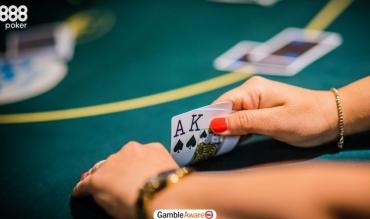Updated November 25, 2025
A lot of success in poker comes from choosing the right hands to play. Seeing as all hands are NOT created equally, you shouldn’t always play the same starting hands from one position to the next.
Generally, it’s also a good idea to play fewer hands from early position (to compensate for the likelihood of having to play out of position post-flop). You can open/play more hands from later positions because of the considerable information and other benefits from being in position.
As a bottom line, if you play too many starting hands (including too many garbage hands), then the negative results of doing this will be compounded throughout the poker hand. You’ll find yourself in difficult-to-navigate, unprofitable post-flop spots.
If you play too few hands, though, the blinds will eat you up, orbit by orbit. You’ll have a tough time supplementing these micro-losses because of your super-tight image. When you pick up a hand, no one will want to give you action.
Keep reading to learn more about Texas Hold’em starting hand charts and how to use them as part of your overall poker strategy.
Poker Hands Chart: Top 10 Starting Hands in Texas Hold’em
As a starting point in determining which hands to play, it’s essential to know which ones are the best and why.
Below is a chart of the Top 10 Starting Hands in Texas Hold’em:
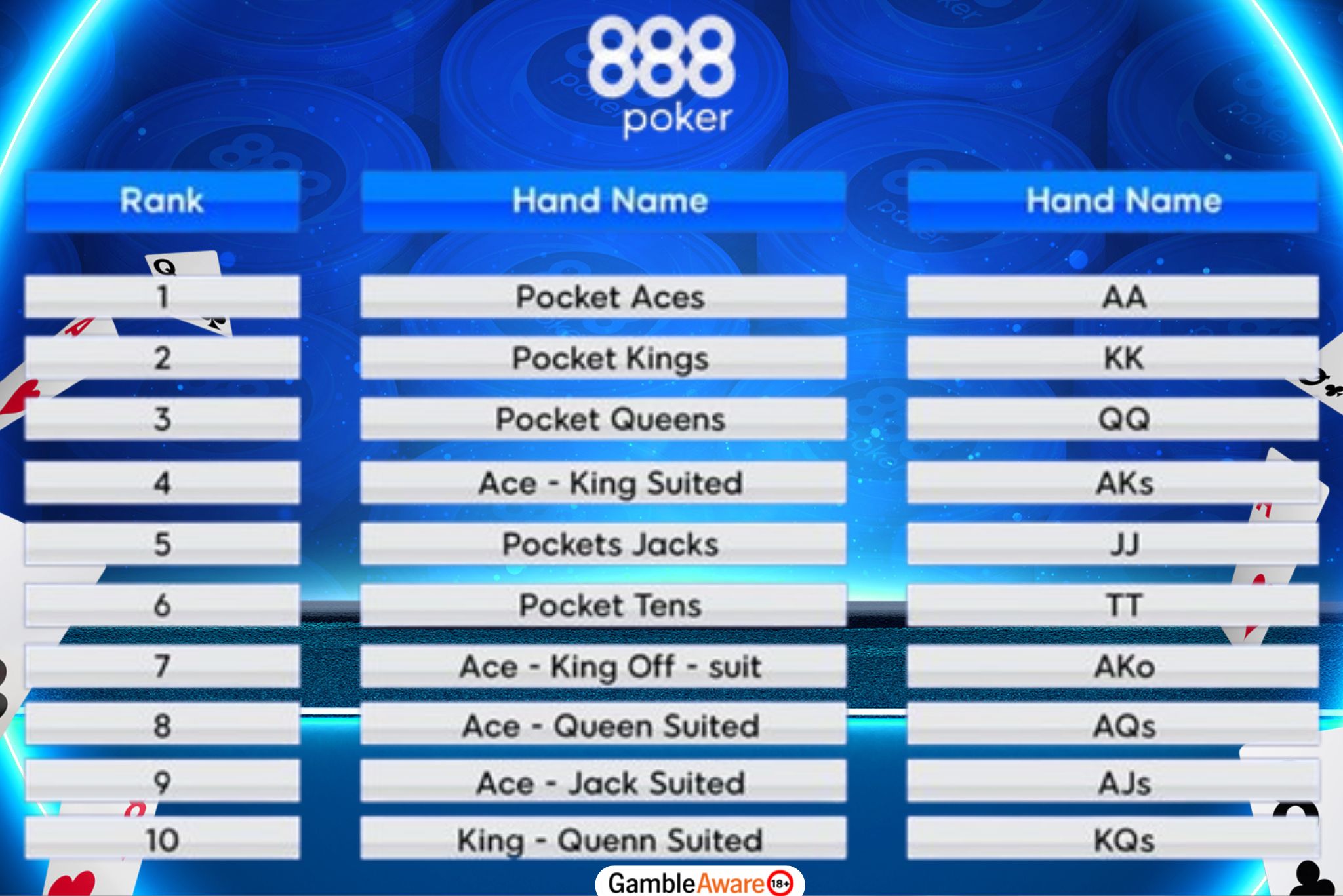
This hierarchy guides the determination of a strong starting hand range. Most of these might be worth preflop raises and even three-bets, depending on the situation.
Making Texas Hold’em poker charts offers an honest look at some of the best hands, and you can base some of your play on these rankings. You may want to be more aggressive with the top hands, and more passive with others.
- What hands are worth bluffing with at times?
- Which hands are worth calling bets with?
- Should I three- or even four-bet with this hand?
These types of charts can help answer many strategy questions.
Starting Hands: The Power of High Cards
You’ll notice a common thread in the chart above. Virtually all these combinations of hands contain various mixes of face cards, showing the power of high cards.
Often, a mere pair will be the winning hand at showdown. Therefore, if your cards are higher than your opponents before a flop, then you have a better chance of winning the hand at showdown.
High cards should always be part of your overall poker strategy. Using better cards gives you an advantage against lesser-skilled opponents.
Pocket pairs can also be key, and our next section offers more on this concept.
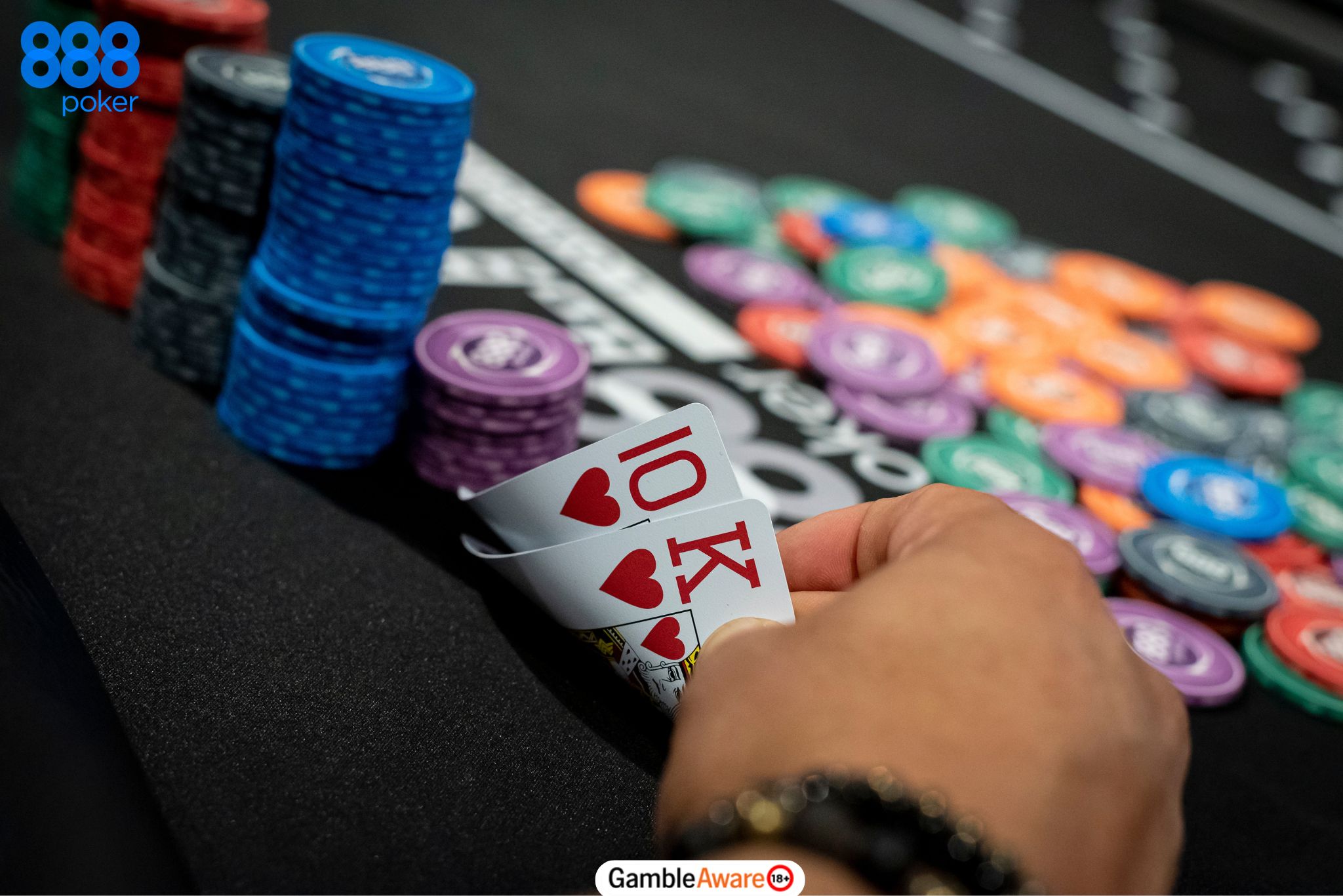
Pairs Vs Unpaired Hands
You’ll also notice from the chart that pocket pairs are generally better than their unpaired counterparts. Even though many of these “two unpaired overcards vs smaller pairs” are usually “coin flips”, with the pocket pair having the slight edge.
For example, in a matchup of QQ vs AKs, the ladies are likely to win 54% of the time. While this may seem like a slight edge, over time, it will add up, and the variance will be in the Queens’ favour!
Even 22 vs AKs (while much, much closer in equity) still gives the pocket pair a slight advantage, putting it at 50.1%! This fact is another example of just how powerful pairs in the hole can be.
If an opponent with an unpaired hand misses on the flop, turn, and river, then you will win the hand.
However, there are some caveats to this concept.
Why is AKs (Ace-King suited) higher than pairs such as JJ and TT in the Top 10 Starting Hands list? The answer to this question centres around playability.
- It’s easier to play AKs or even AQs because either you’ll hit top pair and play up front.
- Or you won’t and can opt to execute a poker bluff.
In other words, it becomes pretty straightforward how you should proceed with the hand. (With the suited combinations of Ace-King, you can also pick up additional equity more easily with flushes or flush draws.)
On the flipside, with pairs like JJ and TT, you already have showdown value in the form of a pair. But these pairs become much more challenging with an overcard (or multiple overcards) on the board.
For example, in a cash game, you might be dealt pocket Jacks. You put in a sizable raise and see two callers. The flop comes out A-K-2. This flop is terrible for those Jacks, as it seems likely that an opponent with an
Ace or a King might have called. Players out of position are even more hard-pressed because one of the opponents leads with a bet, indicating an Ace or a King.
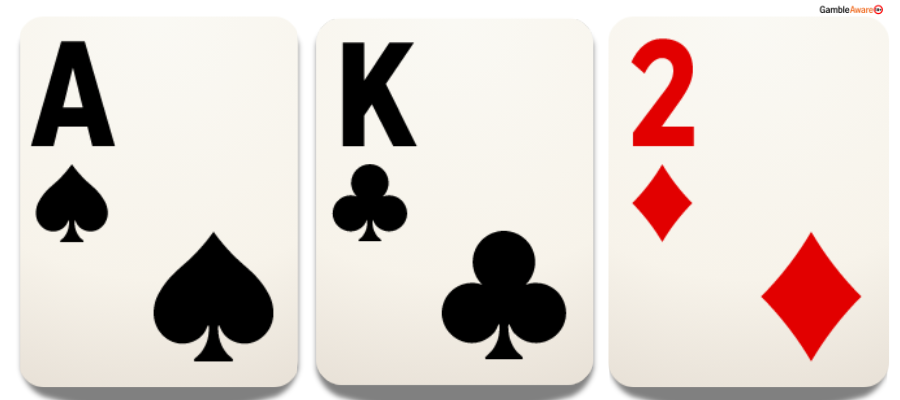
If you do have position and the two opponents check, you can pick up the pot with a bet, but this is dicey. A call could indicate that one of the players has a better hand already or at least a solid drawing hand.
There is another concern to consider with these types of hands. Even if you think your opponent is bluffing in a hand, it can be challenging to call down three streets with something that’s essentially third pair on a board with two overs.
When looking at Texas Hold’em starting hands charts, these are poker probability scenarios also to consider when plotting your strategies at the table.
Suited vs Unsuited Hands
You may have noticed that AKs ranks significantly higher on the list than its off-suit counterpart. As mentioned before, AKs has greater playability than AKo (Ace-King off-suit).
Whenever cards are suited, they have a better chance of flopping or turning into 4-to-a-flush, which means they’ll have higher poker equity and win more often.
Having flush draws can also give players a good enough reason to bet as a semi-bluff, which is a bluff when you have a chance to draw to a winner. As you likely know, when you play aggressive poker by betting or raising, you can push your opponent off the pot and make them fold.
Note that a suited hand has a 5% equity advantage over its off-suited counterpart! This fact means that if two identical hands (in terms of value) got it in preflop, the suited one would have 52.5% equity, while the off-suit hand would have 47.5% equity.
EMBED VIDEO:
Even though it’s not a substantial amount, it shows the value of playing suited hands more than unsuited ones.
A 5% advantage over the long run gives you a better chance of realising stronger winnings in these types of situations.
Poker Hands Chart: Common Starting Hand Nicknames
In poker, it’s helpful to know some common nicknames for various hand combinations. This way, if you ever wanted to reference your hand with a friend, it can be a natural alternative.
Additionally, if you’re ever fishing for information from an opponent on what they held during the hand, some players will refer to what they had by its nickname.
Poker players can be creative and have developed a rich glossary of poker hands.
Here’s a look at some of those in the chart below:
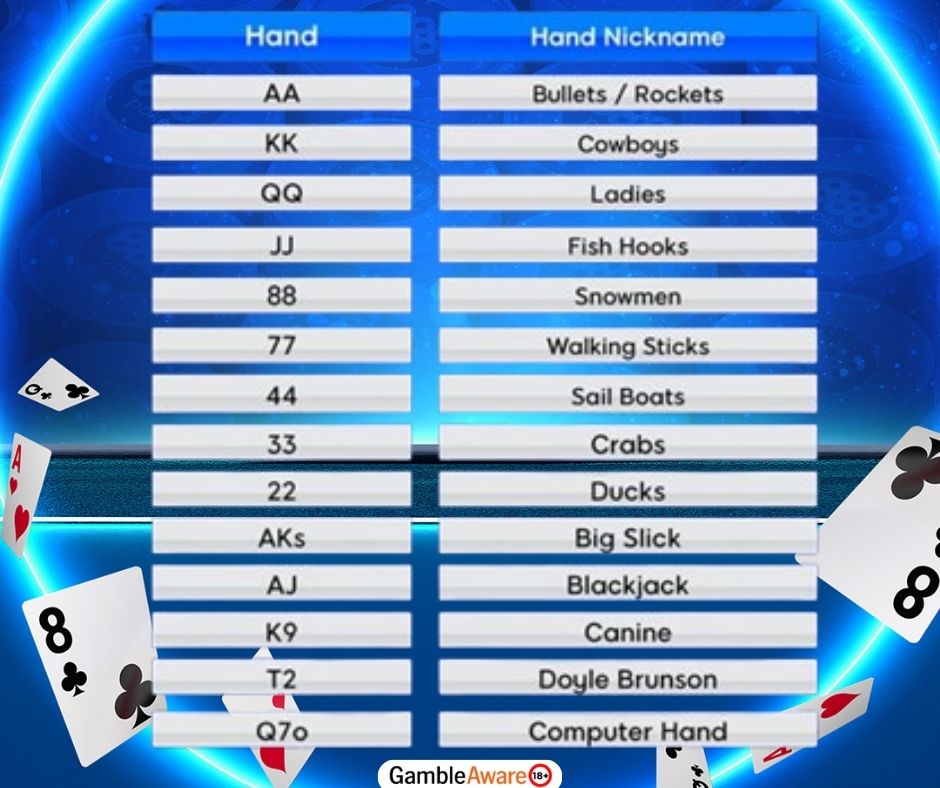
You'll notice that most hands' nicknames (especially pocket pairs) describe the hand's physical appearance.
For example, pocket fours resemble the sails on a boat, while pocket deuces look like a duck sitting on the water. The “A” in aces can indeed look similar to bullets or rockets, which is why those nicknames are used.
Here are the reasons for “miscellaneous hands” at the bottom of the list:
- AJ – Blackjack: These two cards in casino blackjack are the best cards, and award a player 21, automatically paying them 3 to 2 on their bet.
- K9 – Canine: If you say the letter "K" and the number "9" together, it sounds like this synonym for a "dog".
- 10-2 – Doyle Brunson: Poker legend, Doyle Brunson, won both his WSOP Main Event titles in back-to-back years (1976 and ‘77) with this hand, amazingly making a full house both times.
- Q7o – Computer Hand: Aptly referenced, as it has exactly 50% equity against a range of complete randomness (any two cards).
In Conclusion
It’s essential to understand that equity (the chance you have to win the pot at showdown at any given point in a hand) and playability are two primary factors when it comes to the best starting hands in Hold’em.
Having two high cards in your hand will boost your chances of winning against your opponent(s), especially if they are loose.
Be sure to study the 20 Essential Poker Charts to get an idea of which hands to open-raise with from each position, if the action has folded to you preflop.
